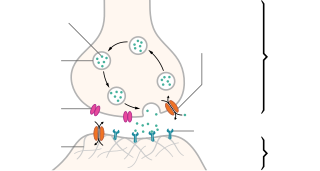
A neurotransmitter is a signaling molecule secreted by a neuron to affect another cell across a synapse. The cell receiving the signal, any main body part, or target cell, may be another neuron, but could also be a gland or muscle cell.
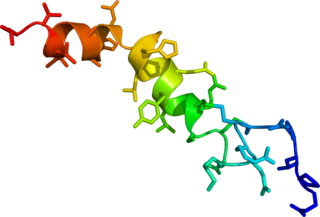
Orexin, also known as hypocretin, is a neuropeptide that regulates arousal, wakefulness, and appetite. The most common form of narcolepsy, type 1, in which the individual experiences brief losses of muscle tone (cataplexy), is caused by a lack of orexin in the brain due to destruction of the cells that produce it.
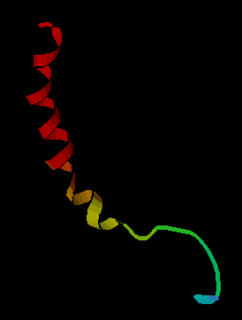
Neuropeptides are chemical messengers made up of small chains of amino acids that are synthesized and released by neurons. Neuropeptides typically bind to G protein-coupled receptors (GPCRs) to modulate neural activity and other tissues like the gut, muscles, and heart.

Neuropeptide Y (NPY) is a 36 amino-acid neuropeptide that is involved in various physiological and homeostatic processes in both the central and peripheral nervous systems. NPY has been identified as the most abundant peptide present in the mammalian central nervous system, which consists of the brain and spinal cord. It is secreted alongside other neurotransmitters such as GABA and glutamate.

Vasoactive intestinal peptide, also known as vasoactive intestinal polypeptide or VIP, is a peptide hormone that is vasoactive in the intestine. VIP is a peptide of 28 amino acid residues that belongs to a glucagon/secretin superfamily, the ligand of class II G protein–coupled receptors. VIP is produced in many tissues of vertebrates including the gut, pancreas, and suprachiasmatic nuclei of the hypothalamus in the brain. VIP stimulates contractility in the heart, causes vasodilation, increases glycogenolysis, lowers arterial blood pressure and relaxes the smooth muscle of trachea, stomach and gallbladder. In humans, the vasoactive intestinal peptide is encoded by the VIP gene.
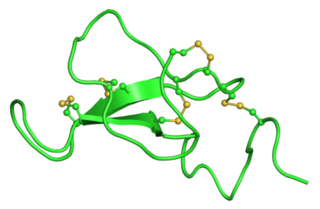
Agouti-related protein (AgRP), also called agouti-related peptide, is a neuropeptide produced in the brain by the AgRP/NPY neuron. It is synthesized in neuropeptide Y (NPY)-containing cell bodies located in the ventromedial part of the arcuate nucleus in the hypothalamus. AgRP is co-expressed with NPY and acts to increase appetite and decrease metabolism and energy expenditure. It is one of the most potent and long-lasting of appetite stimulators. In humans, the agouti-related peptide is encoded by the AGRP gene.
Melanin-concentrating hormone (MCH) is a cyclic 19-amino acid orexigenic hypothalamic peptide originally isolated from the pituitary gland of teleost fish, where it controls skin pigmentation. In mammals it is involved in the regulation of feeding behavior, mood, sleep-wake cycle and energy balance.

Relaxin is a protein hormone of about 6000 Da first described in 1926 by Frederick Hisaw.
Neuromodulation is the physiological process by which a given neuron uses one or more chemicals to regulate diverse populations of neurons. Neuromodulators typically bind to metabotropic, G-protein coupled receptors (GPCRs) to initiate a second messenger signaling cascade that induces a broad, long-lasting signal. This modulation can last for hundreds of milliseconds to several minutes. Some of the effects of neuromodulators include: alter intrinsic firing activity, increase or decrease voltage-dependent currents, alter synaptic efficacy, increase bursting activity and reconfiguration of synaptic connectivity.

Galanin is a neuropeptide encoded by the GAL gene, that is widely expressed in the brain, spinal cord, and gut of humans as well as other mammals. Galanin signaling occurs through three G protein-coupled receptors.

The lateral hypothalamus (LH), also called the lateral hypothalamic area (LHA), contains the primary orexinergic nucleus within the hypothalamus that widely projects throughout the nervous system; this system of neurons mediates an array of cognitive and physical processes, such as promoting feeding behavior and arousal, reducing pain perception, and regulating body temperature, digestive functions, and blood pressure, among many others. Clinically significant disorders that involve dysfunctions of the orexinergic projection system include narcolepsy, motility disorders or functional gastrointestinal disorders involving visceral hypersensitivity, and eating disorders.
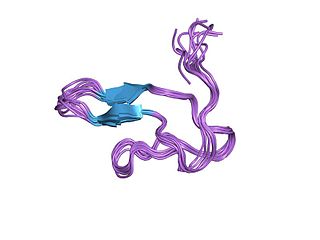
Cocaine- and amphetamine-regulated transcript, also known as CART, is a neuropeptide protein that in humans is encoded by the CARTPT gene. CART appears to have roles in reward, feeding, and stress, and it has the functional properties of an endogenous psychostimulant.
Neuromedin U is a neuropeptide found in the brain of humans and other mammals, which has a number of diverse functions including contraction of smooth muscle, regulation of blood pressure, pain perception, appetite, bone growth, and hormone release. It was first isolated from the spinal cord in 1985, and named after its ability to cause smooth muscle contraction in the uterus.

Relaxin/insulin-like family peptide receptor 3, also known as RXFP3, is a human G-protein coupled receptor.

Relaxin/insulin-like family peptide receptor 1, also known as RXFP1, is a human G protein coupled receptor that is one of the relaxin receptors. It is a rhodopsin-like GPCR which is unusual in this class as it contains a large extracellular binding and signalling domain. Some reports suggest that RXFP1 forms homodimers, however the most recent evidence indicates that relaxin binds a non-homodimer of RXFP1.

Relaxin/insulin-like family peptide receptor 4, also known as RXFP4, is a human G-protein coupled receptor.

Relaxin/insulin-like family peptide receptor 2, also known as RXFP2, is a human G-protein coupled receptor.

Neuropeptide S (NPS) is a neuropeptide found in human and mammalian brain, mainly produced by neurons in the amygdala and between Barrington's nucleus and the locus coeruleus, although NPS-responsive neurons extend projections into many other brain areas. NPS binds specifically to a G protein-coupled receptor, NPSR. Animal studies show that NPS suppresses anxiety and appetite, induces wakefulness and hyperactivity, including hyper-sexuality, and plays a significant role in the extinction of conditioned fear. It has also been shown to significantly enhance dopamine activity in the mesolimbic pathway, and inhibits motility and increases permeability in neurocrine fashion acting through NO in the myenteric plexus in rats and humans.
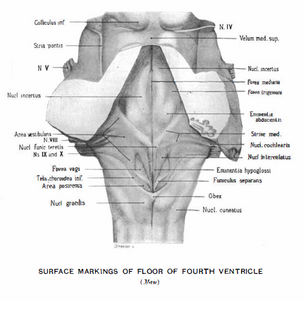
The nucleus incertus is a region of the rodent pontine brainstem just ventral to the 4th ventricle. The term was coined by George Streeter based on its unknown function at the time, to name a group of cells he observed near the midline of the floor of the 4th ventricle.

Relaxin family peptide hormones in humans are represented by 7 members: three relaxin-like (RLN) and four insulin-like (INSL) peptides. This subdivision into 2 classes is based primarily on early findings, and does not reflect the evolutionary origins or physiological differences between peptides. For example, it is known that the genes coding for RLN3 and INSL5 arose from one ancestral gene, and INSL3 shares origin with RLN2 and its multiple duplicates.

















